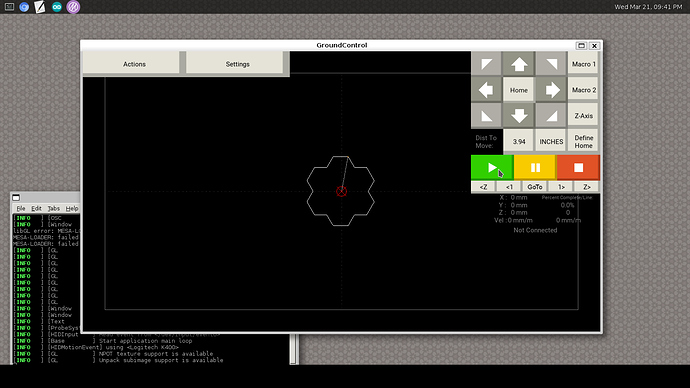Raspberry Pi running in KDE Window Manager, wayland version
This is a solution, I came up with for running GroundControl or kivy python apps inside an X11 window manager while using a mouse or touchpad. If you are using a touchscreen then running KivyPie is probably the safe choice or running kivypie with the trapped cursor mod that was discussed and uploaded by Kingley in this earlier forum thread.
[Disclaimer] As of this writing I have not yet received my Maslow kit, and I have only been able to perform limited testing on a Raspberry Pi 3b with a bluetooth keyboard and touchpad (Logitech K400R).
Also, be warned you will need to enable the [experimental] GL driver in raspi-config and that the current ‘KDE Window manager wayland version’ being used is considered a [PREVIEW] release.
Disclaimer aside, I have been able to run GroundContol in a windowed environment without any screen lag or the missing cursor problem, as encountered when using KivyPie without a touchscreen.
Raspbian Stretch Lite install
Download Raspbian Lite https://www.raspberrypi.org/downloads/raspbian/
Follow instructions per your OS, to install it on an SD card.
I found this guide very useful for installing various desktop environments in the Raspbian Lite distro.
Raspberry Pi Forums
Boot up your raspberry pi 3 and run the following commands, if you need to setup wifi you can do so with choosing network options in sudo raspi-config
sudo apt-get update
sudo apt-get upgrade
sudo apt-get dist-upgrade
Reboot and start raspi-config again. Make the appropriate setting changes for your locale. Choose option 7. Advanced Options and then select A7. GL Driver. You will be given 3 options:
- G1 (Full KMS)
- G2 (Fake KMS)
- G3 Legacy
For this build I choose G1 (Full Kernel Module support). Save and exit out, you will be asked to reboot again.
xserver, kwin-wayland installation
The following commands will pull in and install a large number of packages and may take some time depending on your internet connection, so be patient.
sudo apt-get install --no-install-recommends xserver-xorg
sudo apt-get install --no-install-recommends xinit
sudo apt-get install kwin-wayland konsole kate
After all the packages are installed, you should be able to start the KDE window manager by running:
startx
This will start the KDE Plasma Window Manager running Qt5 libs. Plasma is a full desktop environment, with lots of eye candy.
Unfortuantly, it also uses a lot of resources, probably not what you want for a CNC controller.
Instead, we will run KDE WM without the Plasma desktop environment. With the following command in the shell.
kwin_wayland --xwayland --exit-with-session=konsole
The screen should turn black with a mouse pointer in the center of the screen followed by konsole app.
The --exit-with-session= option lets us gracefully return to a command prompt when closed, otherwise you will have to open another tty and kill the process. The key thing is that running this way only uses 124 Megs of RAM.
As a test you should be able to run glxgears from inside konsole and see achieve a frame rate of 60 fps.
Install Kivy manually
Install the following packages with apt-get and python pip.
[Note] The pip installs here may be newer versions of whats is in the ‘requirements_linux.txt’ and which uses kivy version 1.9.1. the latest stable version is 1.10.0 and we will be compiling the latest developer branch from git based off 1.10.
sudo apt-get install libsdl2-dev libsdl2-image-dev libsdl2-mixer-dev libsdl2-ttf-dev pkg-config libgl1-mesa-dev libgles2-mesa-dev python-setuptools libgstreamer1.0-dev git-core xclip
sudo apt-get install gstreamer1.0-plugins-{bad,base,good,ugly}
sudo apt-get install gstreamer1.0-{omx,alsa} python-dev libmtdev-dev
sudo apt-get install python-pip libffi-dev
sudo apt install libsdl1.2-dev
sudo pip install -U Cython==0.27.3
sudo pip install pyserial
sudo pip install appdirs
sudo pip install packaging
sudo pip install pyparsing
sudo pip install requests
sudo pip install six
sudo pip install pywayland
sudo apt-get install python-pygame
Download the latest branch of Kivy from Git Hub.
git clone https://github.com/kivy/kivy
cd kivy
Build kivy in place, per the instructions on kivy.org :Note we are adding the USE_WAYLAND flag when running make.
USE_WAYLAND=1 USE_X11=1 make
Compiling kivy can take some time. I did not time it personally, but walked away for 10 or 15 minutes and when I came back it had completed.
Run the following commands to add your kivy development folder path to your .profile.
echo "export PYTHONPATH=$(pwd):\$PYTHONPATH" >> ~/.profile
source ~/.profile
Test kivy with one of the example apps.
cd kivy/examples/demo/pictures
python main.py
If everything is installed properly you should be able to interact with the Pictures app using your mouse or touchpad.
Install and run GroundControl
From your home directory download or clone the GroundControl program.
git clone https://github.com/MaslowCNC/GroundControl.git
Add yourself to the dialout group to allow access to the serial port.
sudo usermod -a -G input,dialout pi
Now start the KDE Window manager.
kwin_wayland --xwayland --exit-with-session=konsole
From inside the konsole terminal app:
cd GroundControl
python main.py
The GroundControl program appears full screen and you should be able to interact with it using your mouse and keyboard. You should also be able to resize the window it runs in!
Install Arduino
Install the Java runtime engine required to run the Arduino IDE.
sudo apt-get install default-jre default-jre-headless
Download the latest arduino IDE from https://www.arduino.cc/
extract the files into your home directory.
tar -xvf arduino-1.8.5-linuxarm.tar.xz
cd arduino-1.8.5
I prefer a portable installation, so instead of running install.sh, I create a folder under the root arduino directory named portable.
mkdir portable
Launch the KDE window manager and konsole terminal app and run the Arduino IDE.
kwin_wayland --xwayland --exit-with-session=konsole
cd arduino-1.8.5
./arduino
This should start the Arduino IDE in small window.
I welcome any feedback, and let me know if you are able to duplicate this or improve upon it.



